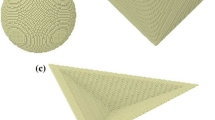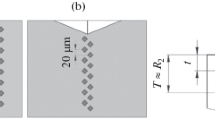Abstract
Nanoscratching of ductile materials creates plastic zones surrounding the scratch groove. We approximate the geometry of these zones by a semicylinder with its axis oriented along the scratch direction. The radius and the length of the cylinder, as well as the length of the dislocations in the network created quantify the plasticity generated. Using molecular dynamics simulations, we characterize the plastic zones in six metals with fcc, bcc, and hcp crystal structures. We find that the plastic zone sizes after scratch are comparable to those after indent. Due to dislocation reactions, the dislocation networks simplify, reducing the total length of dislocations. As a consequence, the average dislocation density in the plastic zone stays roughly constant. Individually, we find exceptions from this simple picture. Fcc metals show strong plastic activity, which even increases during scratch. The hcp metals on the other side show the least plastic activity. Here the plasticity may be strongly reduced during scratch and particularly during tip withdrawal.







Similar content being viewed by others
References
Johnson, K.L.: Contact Mechanics. Cambridge University Press, Cambridge (1985)
Fischer-Cripps, A.C.: Nanoindentation, 2nd edn. Springer, New York (2004)
Durst, K., Backes, B., Göken, M.: Indentation size effect in metallic materials: correcting for the size of the plastic zone. Scr. Mater. 52, 1093–1097 (2005)
Ruestes, C.J., Bringa, E.M., Gao, Y., Urbassek, H.M.: Molecular dynamics modeling of nanoindentation. In: Tiwari, A., Natarajan, S. (eds.) Appl. Nanoindentation Adv. Mater., pp. 313–345. Wiley, Chichester, UK (2017). (Chap. 14)
Gao, Y., Ruestes, C.J., Tramontina, D.R., Urbassek, H.M.: Comparative simulation study of the structure of the plastic zone produced by nanoindentation. J. Mech. Phys. Solids 75, 58–75 (2015)
Alabd Alhafez, I., Ruestes, C.J., Gao, Y., Urbassek, H.M.: Nanoindentation of hcp metals: a comparative simulation study of the evolution of dislocation networks. Nanotechnology 27, 045706 (2016)
Komanduri, R., Chandrasekaran, N., Raff, L.M.: MD simulation of indentation and scratching of single crystal aluminum. Wear 240, 113–143 (2000)
Mulliah, D., Christopher, D., Kenny, S.D., Smith, R.: Nanoscratching of silver (100) with a diamond tip. Nucl. Instrum. Methods B 202, 294–299 (2003)
Mulliah, D., Kenny, S.D., Smith, R., Sanz-Navarro, C.F.: Molecular dynamic simulations of nanoscratching of silver (100). Nanotechnology 15, 243–249 (2004)
Jun, S., Lee, Y., Kim, S.Y., Im, S.: Large-scale molecular dynamics simulations of Al(111) nanoscratching. Nanotechnology 15, 1169–1174 (2004)
Fang, T.-H., Liu, C.-H., Shen, S.-T., Prior, S.D., Ji, L.-W., Wu, J.-H.: Nanoscratch behavior of multi-layered films using molecular dynamics. Appl. Phys. A 90, 753–758 (2008)
Zhang, J.J., Sun, T., Hartmaier, A., Yan, Y.D.: Atomistic simulation of the influence of nanomachininginduced deformation on subsequent nanoindentation. Comput. Mater. Sci. 59, 14–21 (2012)
Mulliah, D., Kenny, S.D., McGee, E., Smith, R., Richter, A., Wolf, B.: Atomistic modelling of ploughing friction in silver, iron and silicon. Nanotechnology 17, 1807–1818 (2006)
Lu, C., Gao, Y., Michal, G., Zhu, H., Huynh, N.N., Tieu, A.K.: Molecular dynamic simulation of effect of crystallographic orientation on nano-indentation/scratching behaviors of bcc iron. In: Luo, J., Meng, Y., Shao, T., Zhao, Q. (eds.) Adv. Tribol., pp. 562–563. Springer, Berlin (2010)
Gao, Y., Ruestes, C.J., Urbassek, H.M.: Nanoindentation and nanoscratching of iron: atomistic simulation of dislocation generation and reactions. Comput. Mater. Sci. 90, 232–240 (2014)
Gao, Y., Brodyanski, A., Kopnarski, M., Urbassek, H.M.: Nanoscratching of iron: a molecular dynamics study of the influence of surface orientation and scratching direction. Comput. Mater. Sci. 103, 77–89 (2015)
Alabd Alhafez, I., Brodyanski, A., Kopnarski, M., Urbassek, H.M.: Influence of tip geometry on nanoscratching. Tribol. Lett. 65, 26 (2017)
Alabd Alhafez, I., Urbassek, H.M.: Scratching of hcp metals: a molecular-dynamics study. Comput. Mater. Sci. 113, 187–197 (2016)
Mendelev, M.I., Kramer, M.J., Becker, C.A., Asta, M.: Analysis of semi-empirical interatomic potentials appropriate for simulation of crystalline and liquid Al and Cu. Philos. Mag. 88, 1723–1750 (2008)
Mishin, Y., Mehl, M.J., Papaconstantopoulos, D.A., Voter, A.F., Kress, J.D.: Structural stability and lattice defects in copper: Ab initio, tight-binding, and embedded-atom calculations. Phys. Rev. B 63, 224106 (2001)
Mendelev, M.I., Han, S., Srolovitz, D.J., Ackland, G.J., Sun, D.Y., Asta, M.: Development of new interatomic potentials appropriate for crystalline and liquid iron. Philos. Mag. 83, 3977–3994 (2003)
Dai, X.D., Kong, Y., Li, J.H., Liu, B.X.: Extended Finnis–Sinclair potential for bcc and fcc metals and alloys. J. Phys. Condens. Matter 18, 4527–4542 (2006)
Mendelev, M.I., Underwood, T.L., Ackland, G.J.: Development of an interatomic potential for the simulation of defects, plasticity, and phase transformations in titanium. J. Chem. Phys. 145, 154102 (2016)
Bertolino, G., Ruda, M., Pasianot, R., Farkas, D.: Atomistic simulation of the tension/compression response of textured nanocrystalline HCP Zr. Comput. Mater. Sci. 130, 172–182 (2017)
Pasianot, R.C., Monti, A.M.: A many body potential for \(\alpha\)-Zr. Application to defect properties. J. Nucl. Mater. 264, 198–205 (1999)
Shao, S., Medyanik, S.N.: Dislocation-interface interaction in nanoscale fcc metallic bilayers. Mech. Res. Commun. 37, 315–319 (2010)
Yaghoobi, M., Voyiadjis, G.Z.: Effect of boundary conditions on the MD simulation of nanoindentation. Comput. Mater. Sci. 95, 626–636 (2014)
Voyiadjis, G.Z., Yaghoobi, M.: Large scale atomistic simulation of size effects during nanoindentation: dislocation length and hardness. Mater. Sci. Eng. A 634, 20–31 (2015)
Ziegenhain, G., Urbassek, H.M., Hartmaier, A.: Influence of crystal anisotropy on elastic deformation and onset of plasticity in nanoindentation: a simulational study. J. Appl. Phys. 107, 061807 (2010)
Alcalá, J., Dalmau, R., Franke, O., Biener, M., Biener, J., Hodge, A.: Planar defect nucleation and annihilation mechanisms in nanocontact plasticity of metal surfaces. Phys. Rev. Lett. 109, 075502 (2012)
Ruestes, C.J., Stukowski, A., Tang, Y., Tramontina, D.R., Erhart, P., Remington, B.A., Urbassek, H.M., Meyers, M.A., Bringa, E.M.: Atomistic simulation of tantalum nanoindentation: effects of indenter diameter, penetration velocity, and interatomic potentials on defect mechanisms and evolution. Mater. Sci. Eng. A 613, 390–403 (2014)
Li, J., Fang, Q., Liu, Y., Zhang, L.: A molecular dynamics investigation into the mechanisms of subsurface damage and material removal of monocrystalline copper subjected to nanoscale high speed grinding. Appl. Surf. Sci. 303, 331–343 (2014)
Li, J., Liu, B., Luo, H., Fang, Q., Liu, Y., Liu, Y.: A molecular dynamics investigation into plastic deformation mechanism of nanocrystalline copper for different nanoscratching rates. Comput. Mater. Sci. 118, 66–76 (2016)
Kelchner, C.L., Plimpton, S.J., Hamilton, J.C.: Dislocation nucleation and defect structure during surface indentation. Phys. Rev. B 58, 11085–11088 (1998)
Ziegenhain, G., Hartmaier, A., Urbassek, H.M.: Pair vs many-body potentials: influence on elastic and plastic behavior in nanoindentation of fcc metals. J. Mech. Phys. Solids 57, 1514–1526 (2009)
Plimpton, St.: Fast parallel algorithms for short-range molecular dynamics. J. Comput. Phys. 117, 1–19 (1995). http://lammps.sandia.gov/
Stukowski, A.: Visualization and analysis of atomistic simulation data with OVITO—the Open Visualization Tool, Model. Simul. Mater. Sci. Eng. 18, 015012 (2010). http://www.ovito.org/
Henderson, A.: Paraview guide, a parallel visualization application. Kitware Inc. (2007). http://www.paraview.org
Stukowski, A., Albe, K.: Extracting dislocations and non-dislocation crystal defects from atomistic simulation data. Model. Simul. Mater. Sci. Eng. 18, 085001 (2010)
Stukowski, A., Bulatov, V.V., Arsenlis, A.: Automated identification and indexing of dislocations in crystal interfaces. Model. Simul. Mater. Sci. Eng. 20, 085007 (2012)
Stukowski, A.: Structure identification methods for atomistic simulations of crystalline materials. Model. Simul. Mater. Sci. Eng. 20, 045021 (2012)
Stukowski, A., Arsenlis, A.: On the elastic-plastic decomposition of crystal deformation at the atomic scale. Model. Simul. Mater. Sci. Eng. 20, 035012 (2012)
Bowden, F.P., Tabor, D.: Friction, lubrication and wear: a survey of work during the last decade. Br. J. Appl. Phys. 17, 1521–1544 (1966)
Tsuru, T., Kaji, Y., Shibutani, Y.: Minimum energy motion and core structure of pure edge and screw dislocations in aluminum. J. Comput. Sci. Tech. 4, 185–193 (2010)
Muzyk, M., Pakiela, Z., Kurzydlowski, K.J.: Ab initio calculations of the generalized stacking fault energy in aluminium alloys. Scr. Mater. 64, 916–918 (2011)
Monnet, G., Terentyev, D.: Structure and mobility of the \(\frac{1}{2} \langle 111 \rangle \{112\}\) edge dislocation in BCC iron studied by molecular dynamics. Acta Mater. 57, 1416–1426 (2009)
Hafez Haghighat, S.M., von Pezold, J., Race, C.P., Körmann, F., Friak, M., Neugebauer, J., Raabe, D.: Influence of the dislocation core on the glide of the \(\frac{1}{2} \langle 111 \rangle \{110\}\) edge dislocation in bcc-iron. Comput. Mater. Sci. 87, 274–282 (2014)
Remington, T.P., Ruestes, C.J., Bringa, E.M., Remington, B.A., Lu, C.H., Kad, B., Meyers, M.A.: Plastic deformation in nanoindentation of tantalum: A new mechanism for prismatic loop formation. Acta Mater. 78, 378–393 (2014)
Tenckhoff, E.: Deformation Mechanisms, Texture, and Anisotropy in Zirconium and Zircaloy, ASTM Special Technical Publication, vol. 966. ASTM International, Philadelphia (1988)
Gunkelmann, N., Alabd Alhafez, I., Steinberger, D., Urbassek, H.M., Sandfeld, S.: Nanoscratching of iron: a novel approach to characterize dislocation microstructures. Comput. Mater. Sci. 135, 181–188 (2017)
Po, G., Cui, Y., Rivera, D., Cereceda, D., Swinburne, T.D., Marian, J., Ghoniem, N.: A phenomenological dislocation mobility law for bcc metals. Acta Mater. 119, 123–135 (2016)
Dezerald, L., Rodney, D., Clouet, E., Ventelon, L., Willaime, F.: Plastic anisotropy and dislocation trajectory in bcc metals. Nat. Commun. 7, 11695 (2016)
Acknowledgements
IAA and HMU acknowledge support by the Deutsche Forschungsgemeinschaft via the Sonderforschungsbereich 926. CJR acknowledges support by ANPCyT PICT-2015-0342, SECTyP-UNCuyo, a donation by the Nvidia Corporation, and computational resources at Mendieta-CCAD-UNC through MinCyT-PDC-SNCAD.
Author information
Authors and Affiliations
Corresponding author
Appendix 1: Depth Dependence of Scratching
Appendix 1: Depth Dependence of Scratching
Besides the surface orientation and the scratch direction, scratching also depends on the scratching depth d. This quantity has been fixed to 3 nm in the main part of the work. In this Appendix, we vary it between \(d=2\) and 4 nm; however, we provide the results only for one fcc metal (Al), one bcc metal (Fe), and one hcp metal (Ti).
The results are summarized in Table 5. The results are quite consistent for the fcc and bcc materials. With increasing depth d, the size factor f increases. This increase is most pronounced for the hard material, Fe, and less dramatic for Al. We attribute this increase to the effects of dislocation mobility, which is influenced by cross-slip and the details of the stress field acting under the tip [51, 52]. In addition, the results after indent also apply in good approximation for the scratch, and the removal of the tip after scratch has only a minor influence on f. These latter assertions only fail for the most shallow scratch in Al.
For the hcp material, Ti, the scratch depth plays a larger role. For the two shallowest indents, \(d=2\) and 3 nm, the plastic zone is relatively small, and almost collapses after removal of the tip, resulting in \(f=1\) or even smaller. However, more stable results are obtained for the deepest indent, \(d=4\) nm. For this depth, the resulting f factor is around 3, in good agreement with the bcc results. Only the fcc size factor is larger for this scratch depth, around \(f=4\).
We conclude that for hcp materials, shallow indents and scratches tend to lose their plastic zones by dislocation annihilation at the surface. A similar result was obtained previously for too small tip sizes [6]. Deeper indents are needed to keep the plasticity surviving.
Rights and permissions
About this article
Cite this article
Alabd Alhafez, I., Ruestes, C.J. & Urbassek, H.M. Size of the Plastic Zone Produced by Nanoscratching. Tribol Lett 66, 20 (2018). https://doi.org/10.1007/s11249-017-0967-9
Received:
Accepted:
Published:
DOI: https://doi.org/10.1007/s11249-017-0967-9




